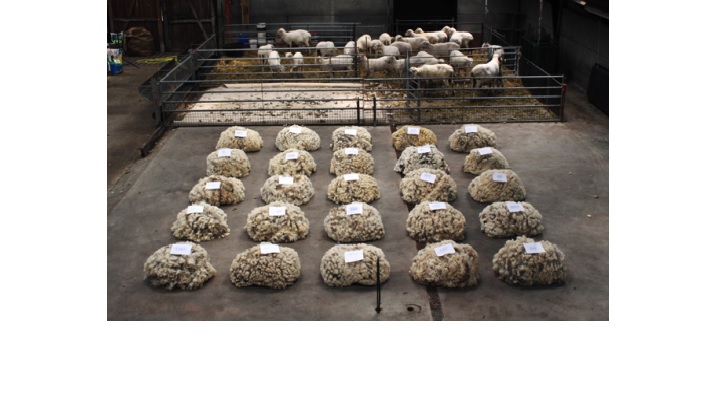
A brief history of the fleece
The term ‘fleece’ refers to the woollen coat obtained after a sheep or ram is sheared, a task undertaken once a year at the end of spring. The skin from these animals, tanned with its wool and used to make warm clothing, is known as sheepskin.
The fluffy appearance typical of modern sheep (especially those of the Merino breed) in the western world is the result of painstaking and centuries-long selection and breeding processes carried out on the Asian Mouflon, mainly in the Middle East. Even though the Merino is today the most widespread breed, there are others in existence which have retained traits from older breeds, and which are of considerable interest from the point of view of genetics.
The fleece is of course the sheep’s distinctive feature. Around 8,000 years ago, however, it was brown in colour, and formed of coarse hairs and shorter, woolly hair, both of which the animal would moult once a year. Archaeological records show the development of two types of fleece between 5000 and 1500 BC: the first, a mixture of more abundant short wool fibres, thickened at the base, combined with a smaller amount of long coarse hair; the second, also a mixture, but one in which the coarse hair had developed into a wool of a type more familiar to the fleeces of today. In the second case, the woollen fibres were of a more uniform length and gauge, and with a rounded tip.
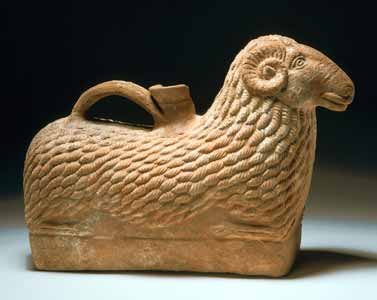
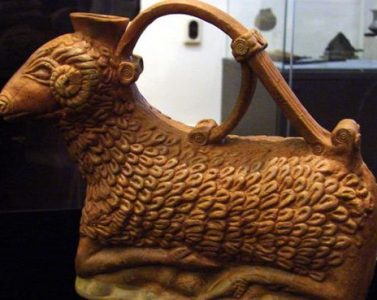
Ancient figurines with sheep motifs depicting in great detail
the bundles of fibre, allowing us to infer the fleece type.
With the Neolithic revolution came the emergence of increasingly settled communities, which in turn led to the cultivation of crops and the rearing of livestock. Husbandry ensured a more or less regular and varied diet (meat and milk), and at the same time made it possible to produce leather, wool and natural fertilisers. During the Iron Age (from around 1500 BC), genetic improvements in the sheep stock led to a reduced tendency to moult: sheep now kept their coat year in year out, transforming the fleece from a protection for the sheep into one that could also be used by humans. This in turn led to two new technological advances: shearing and dyeing, evidence of which has been found at archaeological sites in the form of fleeces and ancient textile fragments, along with artistic depictions of animals –including sheep – and of people wearing clothing made from wool.

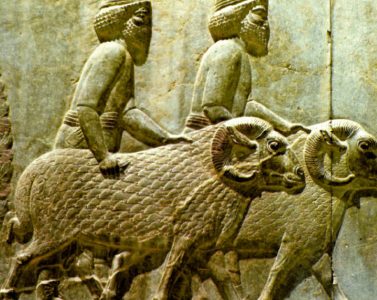
Superintendent Ebih-il of Mari, dressed in the typical Sumerian skirt, the Kaunakes. Shepherds tending their flocks and woolly rams are proudly represented in the Royal Standard of Ur.
Among the communities of ancient Mesopotamia, a kaunakes (from the Greek, meaning ‘thick cloak’) was a man’s garment worn by the Sumerians during rituals (although it was originally worn by shepherds). Looking something like a skirt, it was made from sheep, with the wool arranged in overlapping tufts. Kaunakes was originally just one of the terms the Sumerians used to refer to sheep (they had, in fact, up to two hundred) and, by allusion, it was later used to refer to the woollen garment itself, the texture of which would have looked a lot like that of the sheepskin products we use nowadays. Sheep in fact played an important role in the Mesopotamian economy, and there are many relief carvings and other pictorial representations of shepherds with their sheep and rams, such as those portrayed in the ‘Peace’ panel in the Standard of Ur.
Elizabeth Wayland Berber, the American expert on the history of textiles, has noted that not all sheep farming was directed at wool production. Those breeds bred for the production of meat would typically have had a shorter lifespan, whereas milk production, which requires longer-living sheep, would have unintentionally resulted in sheep with longer wool, something which in turn would have been stimulated through shearing. The evolution of the fleece has to be understood alongside an understanding of the development of the craft of textiles, which advanced parallel to biological changes as sheep’s wool came to be an increasingly important resource.
Wool in felted form would almost certainly have been the first of all the fabrics derived from animal fibres. Wool felting depends on the fact that the surface of the wool fibres are covered with microscopic scales. When the fibres are rubbed together, the scales mesh, such that an entangled mass of cloth is formed. Both heat, which relaxes the fibres, and moisture, which lubricates them, enable felting. Heat and moisture, of course, occur naturally when the sheep is moulting. Caps of thick solid felt dating from the Bronze Age are preserved in the National Museum of Denmark, Copenhagen. These pieces, over 3,500 years old, were found in ancient burial sites, excavated in different places in Denmark.
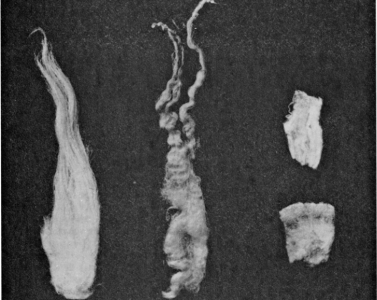
Bundles of fibre from two types of modern wool, showing different fibre length and calibre. The bundle on the far left is from a natural hair fleece and consists of two types of fibre: long straight hairs can be seen protruding from a tight mass of fine wool. On the right, the long wool bundle comes from an ordinary fleece. Dense in appearance, its fibres are long and thick. The bundle below right is a medium fine grade of wool, and that at the top, a fine grade. The rectangular form of these last two bundles is due to the evenness of the hairs’ diameter and length.
Over time, selective breeding reduced the diameter of the coarse thick hair in the outer fleece, while at the same time making the smooth inner hair thicker, with a diameter of some 15 micrometres (thousandths of a millimetre). Most early archaeological textile remains have a fibre of a diameter of around 20 micrometers, as is normal today. New dyeing techniques developed in the Middle East around 1000 BC triggered an improvement in the selective breeding of white wool sheep. There were also improvements in shearing tools, many of which have been found in archaeological sites dating back from the end of the Iron Age and in Roman sites all over Europe. These were rudimentary scissors formed by two facing blades linked by a steel arch that functioned as a spring. Fabric and sheep leather archaeological remains dating from the same period display a change in the wool structure. Likewise, Roman age fabric found in archaeological sites also shows how the fleece was being transformed.
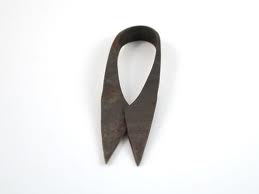
Old shearing scissors
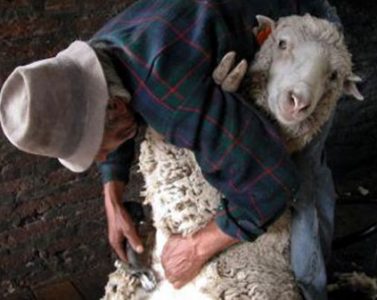
Shearing
Fine and medium fine grades of wool became increasingly important in Europe during the Middle Ages. In the Mediterranean area, and in Spain in particular, production using sheep which produced finer grades of wool led to the rise in prominence of the Merino, the breed which produced the highest quality of all. Until the last third of the eighteenth century, the raising of the Merino was controlled by the Honrado Concejo de la Mesta (1273-1837),making it effectively a Spanish monopoly, its export abroad was banned; their flocks would alter the landscape of the plateau and the cattlemen reached sufficient importance to influence the political history of the nation. Present-day Merino livestock worldwide originates almost in its entirety from sheep originally bred in Spain and exported at this time. Subsequent development, taking place over a little less than a century, saw the introduction of the Spanishbred Merino into a range of western (France, Great Britain, Germany and the USA) and southern-hemisphere (Argentina, South Africa, New Zealand and Australia) countries, giving rise to a variety of new breeds: the Rambouillet, Negretti, American Merino, Vermont, Delaine and the Australian Merino. The enormous growth of grassland combined with the introduction of these new varieties would lead to a historically unprecedented growth in the mass of livestock and herds. One only has to recall that of Australia – the world’s number one producer of wool – it is said that for every hundred sheep, there is but one person.

Ines
Interesante articulo. Gracias por nombrar fuentes en las que poder alimentar nuestra curiosidad. Le falta un final al articulo.. o habrá segunda parte? Enhorabuena y gracias! Lo comparto!
madeinslow
Muchas gracias!! Haremos una segunda parte.
María Isabel Galindo
Aprender a trabajar un material sin conocer un poco de su historia no tiene sentido, es por ésto que me he tomado la molestia de llevar esta información para que se unan el quehacer con el saber.
Teresa herminia carballo
Hola me sirvio muchisimo tu reseña sobre el vellon,muchas gracias , soy artista expositora y hago cuadros en vellon. Teresa carballo
Emma
Me encanta!!! No estaría demás trasladarlo a la etiqueta del ovillo en forma de reseña a vuestra web, si no está hecho ya…
Seguir así!!!!
María Zamorano F
gracias tenía que hacer un trabajo sobre el vellón y el artículo me sirvió mucho,hago clases de telar decorativo y,telar Mapuche y de vellón agujado y fieltro,gracias
madeinslow
Gracias a ti! Nos alegramos mucho de haberte ayudado.
Tirsa
Muchas gracias por el artículo, además de interesante me ha sido muy útil pues trabajo con vellón y fieltro… y tenía la necesidad de conocer más en profundidad, con lo leído se me abre un mundo a seguir descubriendo.
Joaquina
Me gustaría saber que quiere significar un duro de vellon. Porque vellon es también una moneda no?
madeinslow
Realmente la expresión es Real de vellón, y es la asociación de una moneda con la lana merina, ya que durante cinco siglos (XIV-XVIII)la lana procedente de la oveja merina monopoliza el mercado a nivel mundial, cotizando en bolsa y constituyendo la principal fuente de divisas del reino. Sería como el término petrodolar o el actual Bitcoin.
Silvia
Mis felicitaciones por la explicación, deseando leer la siguiente parte!!
Giuliana
Torturan animales al sacarles la piel!? Como es el
Proceso para eso?
madeinslow
Nooo, no es sacarles la piel, se trata de esquilar su lana. Sería como si vas al peluquero a raparte el pelo ;-), verdad que no te arranca la cabellera!
Puedes ver una muestra del proceso en el siguiente video del Open de esquileo en Castuera hacia el minuto 9
Angela Rojas
Una pregunta la lana natural esta en el grupo de la poliamida? Porque?
madeinslow
Una poliamida es un tipo de polímero que contiene enlaces de tipo amida. Por lo que por su estructura química, es una poliamida natural como la seda. Es una fibra natural de origen animal.
Pero al hablar de poliamidas siempre pensamos en las diferentes fibras químicas sintéticas, obtenidas a partir de derivados de productos petrolíferos y aceites como el nylon, poliéster, acrílico, elastano